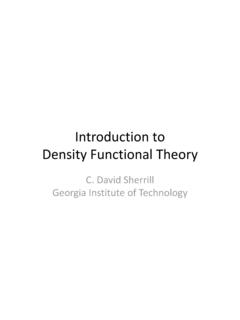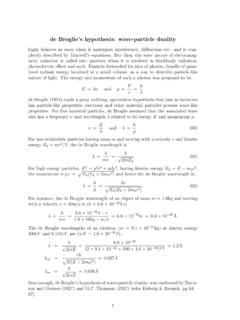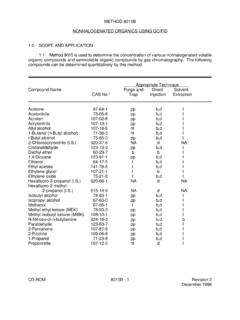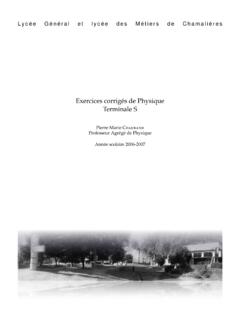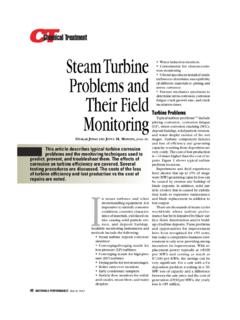Transcription of A Brief Review of Elementary Quantum Chemistry
1 A BriefReviewofElementaryQuantumChemistryC . DavidSherrillSchool of ChemistryandBiochemistryGeorgiaInstitute of TechnologyLastRevisedon27 January20011 Contents1 .. ect.. ElectronicAngularMomentum..62 TheSchr Schr odingerEquation.. Schr odingerEquation..103 .. Operators.. QuantumMechanics.. QuantumMechanics..204 Postulatesof QuantumMechanics265 a Box ..316 ..357 .. theNuclearHamiltonian..438 Many-ElectronWavefunctions..4831 TheMotivationforQuantumMechanicsPhysicis tsat theendof thenineteenth centurybelievedthatmostof thefunda-mentalphysicallawshadbeenworked nementsto get\anextradecimalplace"of accuracy. Asit turnsout,the eldof physicswas transformedprofoundlyin theearlytwentiethcenturyby Einstein'sdiscoveryof relativity andby thedevelopment of hashadfairlylittleimpactonchemistry, allof theoreticalchemistryis of quantummechanicswasinitiallymotivatedby two ob-servationswhich demonstratedtheinadeqacyof \ultravioletcatastrophe"andthephotoelect rice anidealizedobjectwhich usedto derive anequationwhich describes theintensity ofblackbodyradiationas a functionof frequencyfora xedtemperature|theresultis knownas worksforlow frequencies,it divergesas 2; thisdivergenceforhighfrequenciesis explainedtheblackbodyradiationin 1900by assumingthattheenergiesof theoscillationsof electronswhich gave riseto theradiationmustbeproportionalto integralmultiplesof thefrequency, ,E=nh (1)Usingstatisticalmechanics,Planck derivedanequationsimilarto theRayleigh-Jeansequation,butwiththeadju stableparameterh.
2 Planck foundthatforh=6:626 10 34J s, theexperimentaldatacouldbe ,Planckcouldnoto era good justi cationforhisassumptionof thisenergyquantizationideaseriouslyuntil Einsteininvoked a similarassumptionto explainthephotoelectrice ectIn 1886and1887,Heinrich Hertzdiscoveredthatultravioletlight cancauseelec-tronsto be ejectedfroma theclassicalwave theoryof light, theintensity of thelight determinestheamplitudeof thewave, andso agreaterlight intensity shouldcausetheelectronson themetalto oscillatemorevi-olentlyandto be ejectedwitha greaterkineticenergy. In contrast,theexperimentshowedthatthekinet icenergyof theejectedelectronsdependsonthefrequency of thelight. Thelight intensity a ectsonlythenumber of thephotoelectrice ectin by Planck'sformula(1),Einsteinassumedthatth eradiationitselfconsistedof packetsof energyE=h ,which arenow ectusingthisassumption,andhe calculateda valueofhcloseto thatobtainedby yearslater,Einsteinshowedthatnotonlyis light quantized,butso atconstant volume(Cv) of a crystalis 3R, whereRis themolargasconstant.
3 Thisworkswellforhightemperatures,butforl ow ableto explainthisresultby assumingthattheoscillationsof atomsabouttheirequilibriumpositionsarequ antizedaccordingtoE=nh ,Planck' important evenfora systemof atomsin acrystal,which shouldbe well-modeledby a systemof massesandsprings( ,byclassicalmechanics). ElectronicAngularMomentumRutherfordpropo sedthatelectronsorbitaboutthenucleusof an that,classically, orbitingelectronsexperiencea centripetalacceleration,andacceleratingc hargesloseenergyby radiating;a stableelectronicorbitis h(2)Quantizationof angularmomentummeansthattheradiusof theorbitandtheenergywillbe quantizedas thehydrogenatomweredueto transitionsof anelectronfromoneallowedorbit/energyto acquiredor releasedin theformof a photonas proposedby Einstein,so that E=h (3)Thisis knownas theBohrfrequencycondition. Thiscondition,alongwithBohr'sexpressionf ortheallowedenergylevels,gives a good match to ,it a photonisp=h (4)Thiscanbe easilyshownas fora photonand =cforanelectromagneticwave, we obtainE=hc (5)Now we useEinstein'srelativity resultE=mc2to nd =hmc(6)6which is equivalent to equation(4).
4 Notethatmrefersto therelativisticmass,nottherestmass,since therestmassof a photonis canbehavebothas a wave (itcanbe di racted,andit hasa wavelength),andas a particle(itcontainspacketsof energyh ), deBrogliereasonedin 1924thatmatteralsocanexhibitthiswave-par ticleduality. Hefurtherreasonedthatmatterwouldobeythes ameequation(4) ,DavissonandGermerobserveddi ractionpatternsby bombardingmetalswithelectrons,con rmingde Broglie' 'sequationo ersa justi cationforBohr'sassumption(2).If wethinkof anelectronas a wave, thenfortheelectronorbitto be stablethewavemustcompleteanintegralnumbe r of , be writtenas2 r=n (7)If we usethedeBroglierelation(4),thiscanbe rewrittenasmvr=n h(8)which is identicalto Bohr'sequation(2).Althoughde Broglie'sequationjusti esBohr'squantizationassumption,it alsodemonstratesa de ciencyof Bohr' leadsto thefamousuncertainty principle x p h(9)Oneresultof theuncertainty principleis thatif theorbitalradiusof anelectronin anatomris knownexactly, thentheangularmomentummustbe 'smodelis thatit speci esrexactlyandit alsospeci esthattheorbitalangularmomentummustbe anintegralmultipleof thestagewas setfora newquantumtheorywhich was consistent withtheuncertainty odingerEquationIn 1925,ErwinSchr odingerandWernerHeisenbergindependentlyd evelopedthenewquantumtheory.
5 Schr odinger'smethod involves partialdi erentialequations,whereasHeisenberg'smet hod employsmatrices;however,a yearlaterthetwomethods wereshownto be mathematicallyequivalent. MosttextbooksbeginwithSchr odinger'sequation,sinceit seemsto have a betterphysicalinterpretationviatheclassi calwave ,theSchr odingerequationcanbe viewed as aformof thewave equationappliedto Schr odingerEquationHerewe follow thetreatment of McQuarrie[1], startwiththeone-dimensionalclassicalwave equation,@2u@x2=1v2@2u@t2(10)Byintroduci ngtheseparationof variablesu(x;t) = (x)f(t)(11)we obtainf(t)d2 (x)dx2=1v2 (x)d2f(t)dt2(12)If we introduceoneof thestandardwave equationsolutionsforf(t) such asei!t(theconstant canbe takencareof laterin thenormalization),we obtaind2 (x)dx2= !2v2 (x)(13)Now we have anordinarydi erentialequationdescribingthespatialampl itudeofthematterwave as a functionof a particleis thesumofkineticandpotentialpartsE=p22m+V (x)(14)8which canbe solved forthemomentum,p, to obtainp=f2m[E V(x)]g1=2(15)Now we canusethede Broglieformula(4)to getan expressionforthewavelength =hp=hf2m[E V(x)]g1=2(16)Theterm!
6 2=v2in equation(13)canbe rewrittenin termsof if we recallthat!= 2 and =v.!2v2=4 2 2v2=4 2 2=2m[E V(x)] h2(17)Whenthisresultis substitutedinto equation(13)we obtainthefamoustime-independentSchr odingerequationd2 (x)dx2+2m h2[E V(x)] (x) = 0(18)which is almostalways writtenin theform h22md2 (x)dx2+V(x) (x) =E (x)(19)Thissingle-particleone-dimensiona lequationcaneasilybe extendedto thecaseof threedimensions,whereit becomes h22mr2 (r) +V(r) (r) =E (r)(20)A two-bodyproblemcanalsobe treatedby thisequationif themassmis replacedwitha reducedmass .It is important to point outthatthisanalogywiththeclassicalwave equationonlygoes so cannot,forinstance,derive thetime-dependentSchr odingerequationin ananalogousfashion(forinstance,thatequat ioninvolves thepartial rstderivative withrespectto timeinsteadof thepartialsecondderivative).Infact,Schr odingerpresentedhistime-independent equation rst,andthenwentback andpostulatedthemoregeneraltime-dependen t Schr odingerEquationWe arenow readyto considerthetime-dependent Schr wereableto derive thesingle-particletime-independent Schr odingerequationstartingfromtheclassicalw ave equationandthedeBroglierelation,thetime- dependent Schr odingerequationcannotbe derived usingelementarymethods andis generallygivenas a postulateof is possibleto showthatthetime-dependent equationis at leastreasonableif notderivable,butthearguments areratherinvolved ( [2], ;Levine[3], ).
7 Thesingle-particlethree-dimensionaltime- dependent Schr odingerequationisi h@ (r;t)@t= h22mr2 (r;t) +V(r) (r;t)(21)whereVis assumedto be a realfunctionandrepresents thepotentialenergyofthesystem(a complexfunctionVwillactas a sourceor sinkforprobability, asshownin Merzbacher[2], ).WaveMechanicsis thebranch of quantummechanicswithequation(21)as (21)doesnotyet account forspinor relativistice coursethetime-dependent equationcanbe usedto derive we writethewavefunctionas a productof spatialandtemporalterms, (r;t) = (r)f(t), thenequation(21)becomes (r)i hdf(t)dt=f(t)24 h22mr2+V(r)35 (r)(22)ori hf(t)dfdt=1 (r)24 h22mr2+V(r)35 (r)(23)Sincetheleft-handsideis a functionoftonlyandtheright handsideis a functionofronly, thetwo sidesmustequala constant. If we tentativelydesignatethisconstantE(sincet heright-handsideclearlymusthave thedimensionsof energy),10thenwe extracttwo ordinarydi erentialequations,namely1f(t)df(t)dt= iE h(24)and h22mr2 (r) +V(r) (r) =E (r)(25)Thelatterequationis onceagainthetime-independent Schr easilysolved to yieldf(t) =e iEt= h(26)TheHamiltonianin equation(25)is a Hermitianoperator,andtheeigenvaluesof a Hermitianoperatormustbe real,soEis (t) arepurelyoscillatory, sincef(t) never changesin magnitude(recallEuler'sformulae i =cos i sin ).
8 Thus if (r;t) = (r)e iEt= h(27)thenthetotalwave function (r;t) di ersfrom (r) onlyby a phasefactorofconstant all,thequantityj (r;t)j2is timeindependent, as we caneasilyshow:j (r;t)j2= (r;t) (r;t) =eiEt= h (r)e iEt= h (r) = (r) (r)(28)Secondly, theexpectationvalueforany time-independent operatoris alsotime-independent, if (r;t) satis esequation(27).Bythesamereasoningapplied above,< A >=Z (r;t)^A (r;t) =Z (r)^A (r)(29)For thesereasons,wave functionsof theform(27) (r;t) is \stationary," buttheparticleit describes is not!Ofcourseequation(27)represents a particularsolutionto equation(21).Thegeneralsolutionto equation(21)willbe a linearcombinationof theseparticularsolutions, (r;t) =Xicie iEit= h i(r)(30) [3]de nesanoperatoras\arulethattransformsa givenfunctionintoanotherfunction"( ).Thedi erentationoperatord=dxis anexample|it transformsa di erentiablefunctionf(x) into anotherfunctionf0(x).Otherexamplesinclud eintegration,thesquareroot,andso operators(theymultiplya function).
9 McQuarrie[1]gives anevenmoregeneralde nitionforanoperator:\Anoperatoris a symbol thattellsyoutodosomethingwithwhatever followsthesymbol"( ).Perhapsthisde nitionis moreappropriateif we want to referto the^C3operatoractingonNH3, quantummechanics,physicalobservables( ,energy, momentum,position,etc.)arerepresentedmat hematicallyby instance,theoperatorcorrespondingto energyis theHamiltonianoperator^H= h22Xi1mir2i+V(31)whereiis anindexover alltheparticlesof have alreadyencoun-teredthesingle-particleHam iltonianin equation(25).Theaveragevalueof anobservableA representedby anoperator^Afora quantummolecularstate (r) isgivenby the\expectationvalue"formula< A >=Z (r)^A (r)dr(32) OperatorsMostof thepropertiesof operatorsareobvious,buttheyaresummarized belowforcompleteness. Thesumanddi erenceof two operators^Aand^Baregivenby(^A+^B)f=^Af+^ Bf(33)(^A ^B)f=^Af ^Bf(34) Theproductof two operatorsis de nedby^A^Bf ^A[^Bf](35) Two operatorsareequalif^Af=^Bf(36)forallfunc tionsf.
10 Theidentity operator^1 does nothing(ormultipliesby 1)^1f=f(37)A commonmathematicaltrick is towritethisoperatorasa sumover acompletesetof states(moreonthislater).Xijiihijf=f(38) Theassociative lawholdsforoperators^A(^B^C) = (^A^B)^C(39) Thecommutative general,^A^B6=^B^A. It is convenient to de nethequantity[^A;^B] ^A^B ^B^A(40)which is calledthecommutatorof^Aand^B. Notethattheordermatters,so that[^A;^B] = [^B;^A]. If^Aand^Bhappento commute,then[^A;^B] = Then-thpowerof anoperator^Anis de nedasnsuccessive applicationsoftheoperator, ^A2f=^A^Af(41) Theexponentialof anoperatore^Ais de nedviathepower seriese^A=^1 +^A+^A22!+^A33!+ (42) quantummechanicsarelinear operators. Alinearoperatoris anoperatorwhich satis esthefollowingtwo conditions:^A(f+g) =^Af+^Ag(43)^A(cf) =c^Af(44)wherecis a constant ,considertheoperatorsd=dxand()2. We canseethatd=dxis a linearoperatorbecause(d=dx)[f(x) +g(x)]=(d=dx)f(x) + (d=dx)g(x)(45)(d=dx)[cf(x)]=c(d=dx)f(x)( 46)However,()2is nota linearoperatorbecause(f(x) +g(x))26= (f(x))2+ (g(x))2(47)Theonlyothercategoryof operatorsrelevant to quantummechanicsis thesetofantilinearoperators,forwhich^A( f+ g) = ^Af+ ^Ag(48)Time-reversaloperatorsareantiline ar( [2],section16-11).




